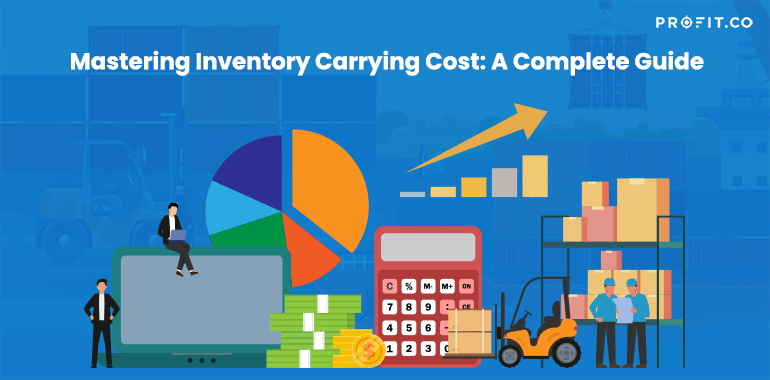Introduction
Managing inventory is akin to walking a tightrope; you must maintain enough stock to meet demand, but not so much that your capital is tied up and gathering dust. Improving material management is a continuous process that is aided by helpful metrics.
Inventory Carrying Cost is an essential metric that sheds light on the true cost of holding inventory, including storage, insurance, and obsolescence.
By mastering this, businesses can optimize inventory levels, reduce costs, and skyrocket profits. Efficient inventory management is critical for business success. One vital metric to keep an eye on is the Inventory Carrying Cost. Understanding and optimizing this cost can significantly impact your bottom line.
What is Inventory Carrying Cost?
Inventory Carrying Cost is the total cost of holding inventory over a specific period. It includes warehousing, insurance, taxes, depreciation, obsolescence, and opportunity costs. Inventory Carrying Cost, along with Average Inventory Ratio, help companies evaluate costs despite turnover.
Formula

Breaking down the components
Storage costs/ Holding cost
Storage costs include rent, utilities, and maintenance for the warehouses where the inventory is stored. Based on your Inventory Days of Supply, your storage costs may vary based on the amount of time inventory needs to be stored before being sold to customers.
Ordering costs
These are the costs related to the procurement process of inventory. It includes costs such as purchase order processing, transportation, inspection, and set up for production runs.
Shortage Costs
These costs arise when demand exceeds the supply of inventory. It can lead to missed sales, loss of customer goodwill, or the need to expedite shipping for replacement goods.
Service Costs
Service costs include insurance and taxes associated with inventory.
Capital Costs
This refers to the opportunity cost of the money invested in inventory. The capital tied up in inventory could have been invested elsewhere.
Risk Costs
This includes costs associated with obsolescence, shrinkage, and potential depreciation in inventory value.
Calculation with Example
Let’s say Company XYZ has the following monthly costs:
Holding Costs (warehouse rent, utilities): $5,000
Ordering Costs (shipping, handling): $3,000
Shortage Costs (lost sales, expedited shipping): $2,000
Average Inventory Value: $50,000
Inventory Carrying Cost = (Holding Costs + Ordering Costs + Shortage Costs) / Average Inventory Value
Inventory Carrying Cost = ($5,000 + $3,000 + $2,000) / $50,000 = 0.2 or 20%
This means that Company XYZ spends 20% of its inventory value on carrying costs.
The inventory, the value of my company, walks out the door every evening.
Inventory Carrying Cost and OKRs
Inventory Carrying Cost is a critical KPI that measures the costs associated with holding inventory over time. Effectively managing this KPI can lead to significant cost savings and improved operational efficiency.
By setting an OKR to reduce Inventory Carrying Costs, organizations can align their strategic goals with tangible, measurable outcomes. Key results within the OKR can focus on specific aspects such as holding, ordering, and shortage costs, which are vital components of the Inventory Carrying Cost KPI. Initiatives, in turn, can be aimed at optimizing these components.
This interconnected approach ensures that efforts are precisely targeted, making the management of Inventory Carrying Costs more focused, efficient, and ultimately successful. Through the OKR framework, organizations can constantly check this KPI and ensure that it aligns with their broader business objectives.
OKR Example with Key Results and Initiatives
Objective: Optimize inventory management to reduce carrying costs
Key Result 1: Decrease inventory holding costs by 15% by the end of Q2
Initiatives:
- Negotiate better terms with the warehouse leasing company to reduce rental expenses.
- Implement energy-efficient solutions in the warehouse to cut down utility costs
Key Result 2: Improve inventory turnover ratio from 5 to 7 by the end of the year
Initiatives:
- Adopt a demand forecasting system to predict inventory needs better.
- Implement a Just-in-Time (JIT) inventory system to reduce excess stock.
Key Result 3: Reduce stock obsolescence costs by 25% in Q3
Initiatives:
- Regularly review inventory for slow-moving items and develop promotions to move these products.
- Implement a real-time inventory tracking system to monitor product shelf life and minimize obsolescence.
To learn more about manging inventory carrying cost
FAQs
1. Why is it important to manage Inventory Carrying Costs?
Efficient management of Inventory Carrying Costs helps maintain a balance between holding too much or too little inventory, which can affect profitability and customer satisfaction.
2. How often should I review my Inventory Carrying Costs?
It’s essential to monitor these costs regularly. Monthly assessments are common, but some businesses benefit from a more frequent analysis depending on the nature of their products and market.
Best Practices
- Regularly monitor carrying costs
Keep an eye on the various components of carrying costs and proactively identify any unusual spikes or trends.
- Adopt inventory management technologies
Utilize inventory management software to track stock levels in real time, which can help in making more informed decisions about ordering and holding inventory.
- Optimize safety stock levels
Regularly review and adjust safety stock levels to ensure that you are not holding too much or too little inventory. Measuring Days Sales in Inventory helps to monitor your inventory and anticipate levels in the future.
- Supplier relationships
Maintain a good relationship with suppliers. It helps in negotiating better terms which can reduce ordering costs.
- Leveraging technology
Incorporating inventory management software can provide real-time data, automation, and analytical tools needed to optimize carrying costs.
Conclusion
Understanding and effectively managing Inventory Carrying Costs is crucial for maintaining a healthy balance between inventory levels and costs, ultimately improving the bottom line. With the strategies outlined in this guide, you’ll be well on your way to mastering Inventory Carrying Costs. Don’t hesitate to employ technology and monitor metrics through an OKR approach to stay ahead.

